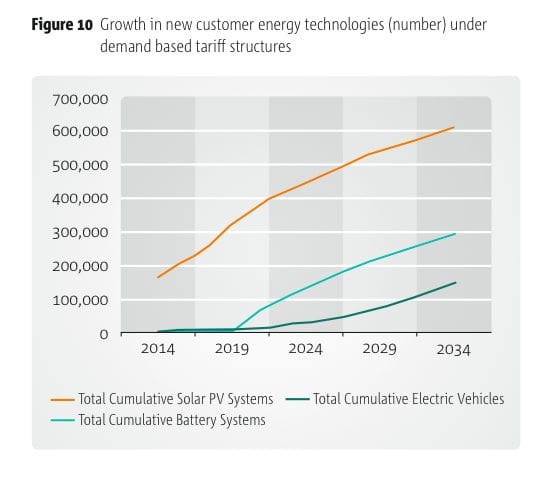South Australian Power Networks is proposing a new form of billing known as “demand tariffs” that it expects will cut the uptake of new rooftop solar systems by half in the state over the next five years, but could encourage more battery storage and electric vehicles.
SAPN unveiled its proposed changes this month as part of a move to “cost reflective” tariffs. The new tariffs – which the network wants to make compulsory from 2017-2020 – will focus on the maximum use by consumers in any month, but overall use outside of those peak times will become relatively cheap.
Critics of the scheme say the new demand tariffs are being structured in such a way that they will penalise solar households, push up their bills, and make solar less attractive for those yet to install.
They say the networks are simply trying to shore up their revenues. Networks in Queensland have lifted fixed network charges, while NSW networks are considering a “solar tax” on exports to the grid.
As SAPN itself admits, it does not want to accept less revenue. “It (the grid) won’t shrink if we just use it less,” it says.
But this goes against years of driving towards energy efficiency, and it also underlines the massive cross subsidy paid by city users to regional users (70 per cent of the cost for 30 per cent of the use) and the cost of building the grid to meet a few hours of peak demand driven by air conditioning use.
SAPN – which earlier this year tried to impose a special $100-a-year network tariff on solar households – appears to agree that demand tariffs will hurt solar. Under the modelling it has done, the uptake of rooftop solar will fall by half over the next five years, although it argues that over 20 years there will be little difference.
 South Australia currently has nearly 200,000 households with rooftop solar, and the highest penetration in the country, at 28 per cent.
South Australia currently has nearly 200,000 households with rooftop solar, and the highest penetration in the country, at 28 per cent.
More than 7 per cent of demand is met by rooftop solar over the year, and more than 25 per cent on some days (see graph on the right).
Within a decade, the state was tipped by the Australian Energy Market Operator to meet all its daytime demand with rooftop solar on some equations.
The SAPN move to demand tariffs will change that forecast. Under the existing tariff, rooftop solar PV is expected to surge over the next decade, trebling the number of installations to nearly 600,000 by 2024. (See graph below).
 But under the proposed changes to a demand tariff (see table below), SAPN expects growth over the next five years to be halved, adding just over 100,000 news systems in the next five years from more than 200,000 under the current scenario.
But under the proposed changes to a demand tariff (see table below), SAPN expects growth over the next five years to be halved, adding just over 100,000 news systems in the next five years from more than 200,000 under the current scenario.
 By 2024, the number of rooftop solar PV systems under the demand scenario is still trailing, but regains most ground by 2034.
By 2024, the number of rooftop solar PV systems under the demand scenario is still trailing, but regains most ground by 2034.
However, in this scenario, the uptake of battery storage is accelerated, although it still only believes widespread uptake will happen from 2019 onwards. Battery storage will enable consumers to avoid using more electricity from the grid at peak times. The uptake of electric vehicles also accelerates under the demand tariff arrangement, although it is not clear why.
Earlier this year, SAPN introduced demand tariffs for large commercial users – at more than 160MWh a year. That meant that the electricity usage component of its network charges fell to just 3.3c/kWh, just one-fifth of its previous peak rate, but businesses were instead hit with hefty “demand charges”.
The solar industry says that the system disadvantages solar because the demand tariffs are extended to 9pm in the evening – when the sun is not shining. But the tariffs don’t focus on peak network demand, just on peak demand from individual users, which can happen at different times.
Rob Passey, from the Australian PV Institute, argued in July that cost reflective tariffs must be what they are labeled as – truly cost reflective. He says these tariffs, proposed by SAPN, are not and are instead focused on maximising revenue.
The new demand tariffs will mean higher network charges for the bulk of households and small businesses, and particularly for those with rooftop solar.
This graph below shows the increased network tariffs hit mostly those solar households at the lower end of annual consumption. As SAPN notes, the outcome for solar households is “less favourable” than for those without PV. It says that solar households have already been “over-rewarded” from their investment.
For businesses, the result is the same. According to the SAPN modelling, the majority of small businesses at the lower end of consumption will be hit with higher charge – more than one-third of them with 50 per cent higher network charges – because, while their consumption is low, much of it comes within the peak periods of 4pm to 9pm.
The solar industry has long argued that tariffs should focus on air-conditioner usage, the primary cause for the big increase in network spending in recent years. SAPN does not appear to have an answer to this problem, saying in its document:
“Stakeholders have reiterated the point that a major contributor to the peak demand issue is air conditioning use in residential homes. How should we allocate the burden across residential vs business customers?”










